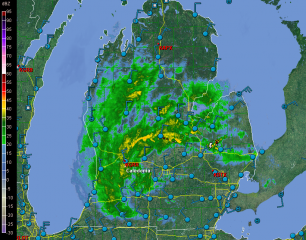You see this? It’s a rare phenomenon in Michigan called “rain” (pronounced rayn). It began yesterday as a closed 500 mb low settled in over the state, and it looks like it will be with us for a while, as the low seems content to linger. You can see a hint of cyclonic swirl on the radar.
And that’s not all: as I write, just a quarter past noon, the KGRR station ob shows a temperature of only 57 degrees. After a heat wave that has stretched from June into early August, with temperatures in Michigan exceeding the 100-degree mark at times, suddenly it looks and feels like autumn. Yesterday I traded my shorts for blue jeans. Even during a normal summer, that rarely happens.
After a historic, severe drought that has mummified Michigan and crippled much of our nation, this steady rain and respite from the heat is beyond welcome. It is a godsend, and those of us who believe in God thank him for it. “He sends his rain on the just and the unjust”–and to the just and the unjust alike, it is a great beneficence.
Next week there’s the possibility of a trough digging down from Canada across the northern-tier states, with jet energy bringing the potential for severe weather in the Great Lakes sometime Wednesday and/or Thursday. But that’s far from certain at the moment. The GFS has painted some wildly varying scenarios, and the most I can see right now is that both it and the ECMWF agree on troughing, with the Euro painting the more potent picture.
Okay, enough of the weather. Let’s talk about music. A while ago, I posted a status update on Facebook that struck me as pretty funny. I have a great appreciation for my own sense of humor, which is a good thing because it means that I have at least one fan. What I hate is when I tell a really hilarious joke and then I don’t get it. Then I have to explain the punch-line to myself, and that just ruins it. Fortunately, that doesn’t happen often. Most of the time, I break out into spasms of laughter, and people look at me oddly, and … getting back to my Facebook post: I figured that I’d share it here and then add onto it whenever I feel inclined. Feel free to post your own additions in the comments section. Without further ado, here are …
Things which, as a jazz musician, I have yet to hear someone say:
.
“Could you turn up the volume? You’re not loud enough.”
“For our first dance, we want you to play ‘Giant Steps.'”
“You want $100 per musician to play at my club? Is that all? I’m doubling your rate. It’s about time you musicians gave yourselves a cost-of-living raise.”
“First tahm playin’ hyeer at the Eyegouge Saloon, eh? Well, I hope yew boys play a lot of Ornette Coleman. Folks hyeer get mighty disturbed if’n they don’t get their Ornette. And another thang: do NOT, if yew value yer life, play ‘Free Bird.'”
“I know we’re an all-white church praise team with three guitars, but we only like playing in the flat keys.”
“What t’hell you mean, you don’t have a trombone player? How can a jazz band not have a trombone? Tell you what: you come back next week with a trombone player and I’ll shell out an extra hunnerd-fifty bucks.”


